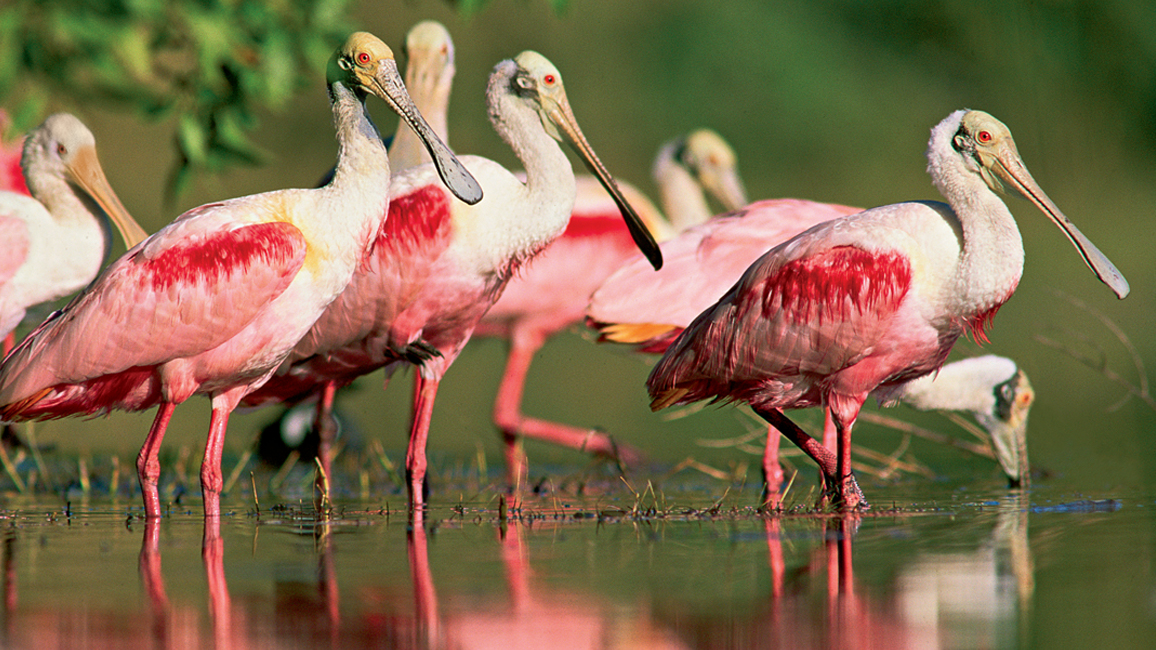
Pretty in Pink
By Ellen LambethCheck out this long-legged pink bird wading in shallow water. Must be a flamingo, you think.
But then you take a second look at that odd bill. That’s no flamingo. It’s a roseate spoonbill. Roseate (ROH-zee-it) is just a fancy word for “pink”–as in “rose-colored.” And there shouldn’t be any question about the other part of the bird’s name.
There are several different kinds of spoonbills. All are long-legged waders with spoon-shaped bills. And all are mostly white–except for this one, the only one found in the Americas (see map). In the United States, you might see roseate spoonbills in Florida and along the Gulf Coast. Otherwise, you’ll have to look for them “south of the border.”
Spoonbills aren’t as big as you might think. They’re not nearly as tall as flamingos, for example. One would stand about eye to eye with a three-year-old kid. The males and females look alike. They have white backs and necks but are mostly pink, of course, with a few splashes of red, yellow, and orange here and there. And both have long, red legs.
Birds of a Feather
Spoonbills spend most of their time with other spoonbills. They stay in flocks to eat, to roost (rest or sleep), and even to raise their young. And, as is true for any wading bird, you won’t find a spoonbill far from water. It’s not too fussy about what kind of water. Saltwater wetlands along the coast make good spoonbill habitat. So do freshwater marshes and swamps. Even ponds and puddles will do. Wherever it is, water is where a spoonbill finds its food.
Eating Out
What’s on a spoonbill’s menu? Any small prey that lives in the water. That usually includes tiny fish, insects, shrimp, and other crunchy little creatures. And, just as it is with flamingos, the pink in spoonbill feathers comes from natural chemicals in the birds’ food.
What’s even more interesting, though, is the way the spoonbill usually feeds. As the bird wades through the water, it swings its head from side to side, with the end of its opened bill underwater. This sweeping motion swirls the water all around it. Tiny creatures get caught up in the swirls and bump against the spoonbill’s spoon bill. When that happens, sensitive nerves in the bill send this message to the bird’s brain: “Shut bill!” Snap–gotcha! Then the bird tips its bill up slightly, tossing the catch to the back of the throat. Gulp! Without wasting any time, it’s right back to sweeping and swirling.
Family Affair
Spoonbills roost and raise families together, usually on top of shrubs and small trees. A nesting colony is called a rookery, and it may include other nesting birds such as egrets and herons. The best place for a rookery is on an island where raccoons and other predators can’t easily get to the nests.
A spoonbill mom and dad work together to build their nest. He collects sticks and other plant stuff, while she puts it all together just so. Then she lays one to five eggs (usually three or four), and both parents take turns sitting on them. Once the eggs hatch, both parents also take turns feeding the downy, white chicks.
As the chicks grow older and bigger, their baby fuzz is replaced by smooth feathers that become pinker and pinker. Their little bills also become longer and spoon-shaped. By the time they’re about three years old, the chicks are all grown up–bright pink like their parents, and ready to start families of their own.
“Pretty in Pink” originally appeared in the May 2015 issue of Ranger Rick magazine.
(Click on each image above for a closer view of the story.)



















